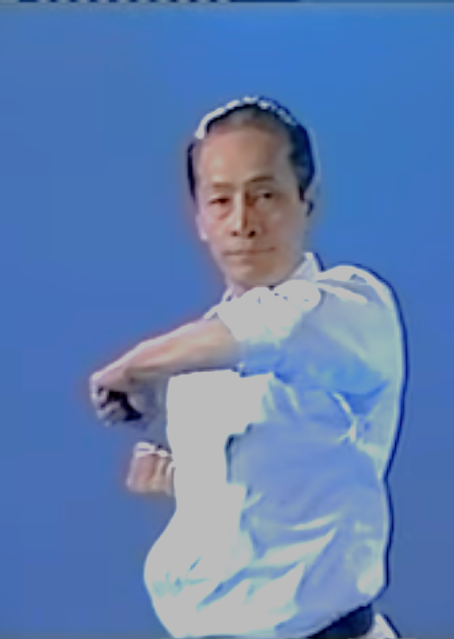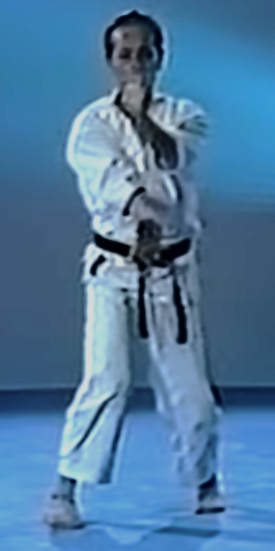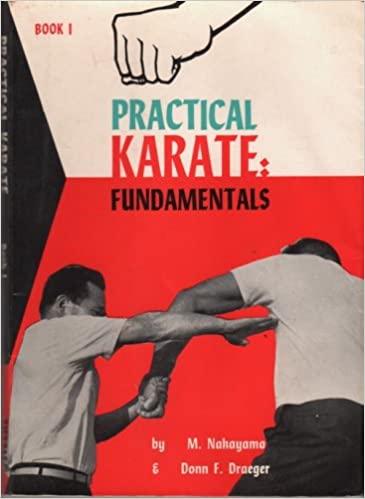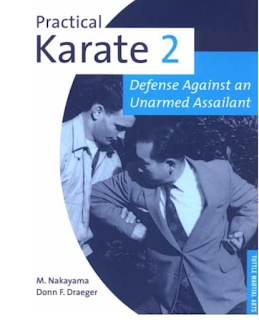 |
| Classic image of Funakoshi Gichin Sensei leading Heian Nidan. A glimpse of 'kata evolution'. |
Introduction:
With 26 movements—with the kiai applied on the decisive points of techniques 11 and 26–there are 12 different waza featured in 平安二段 (Heian Nidan). It is the first kata in classical Shotokan-Ryu to feature keriwaza, both yoko-keage and mae-geri. Standout features include six waza which use both hands/arms simultaneously and the use of rear arm defenses rotating into gyaku-hanmi (Zenkutsu). Half the kata, 13 movements, utilize kokutsu-dachi, within which transitions (between hanmi and shomen) must not interfere with stance form; in particular, the sasae-ashi. Furthermore, the correct use and trajectories of the moving leg, and placement of the feet and toes, should be progressively refined. Like the other four Heian kata a lightness in the muscles should be consciously maintained with “…snap being achieved via shime of the joints (as opposed to forced muscle tension) and both swift and precise actions”.
Here are the 12 different waza featured in Heian Nidan:
1. Jodan haiwan sokumen-uke doji ni zenwan hitai mae yoko-kamae (Kokutsu-dachi).
2. Jodan sotonagashi-uke doji ni kentsui sokumen sotomawashi uchi (Kokutsu-dachi).
3. Chudan
sokumen-zuki (Kokutsu-dachi).
4. Okuribashi
kara ryo ken koshi kamae (Sagi ashi dachi) soshite chudan sokuto yoko-geri
keage doji ni jodan uraken yokomawashi uchi.
5. Chudan
shuto-uke (Kokutsu-dachi).
6. Chudan te
osae-uke doji ni chudan tateshihon nukite (Zenkutsu-dachi).
7. Chudan
uchi-uke (Zenkutsu, Gyaku hanmi).
8. Chudan
mae-geri keage.
9. Chudan
gyaku-zuki (Zenkutsu-dachi).
10. Chudan
morote-uke (Zenkutsu-dachi).
11. Gedan-barai
(Zenkutsu).
12. Jodan age-uke (Zenkutsu).
Master Itosu Anko allegedly formulated the five Pinan kata in the very early 20 century, largely based on Kushanku (Kanku Dai). Funakoshi Gichin Sensei relabeled them ‘Heian’ and reversed the order of Shodan and Nidan. It is said that he did this due to Pinan Nidan being ‘more technically difficult’ than Shodan. However, 'more than its movements', “..the applications are of a higher level and more diverse”. In this regard, consider the 12 different waza in Heian Nidan in comparison to the five in Heian Shodan.
Another factor in this regards is that, while strung
together and applied as renzokuwaza, Heian Shodan largely consists of single
waza with fumidashi; whereas Nidan features four distinct and flowing
combinations. In particular, the use of Gyaku-Hanmi with the rear arm uchi-uke
stands out; moreover, this is a prototype for Kanku Dai, Kanku Sho, and so forth.
Indeed within this waza is the ‘basic’ of 'legs followed by hands'. This blueprint is very important in karate and self-defense as a whole.
As mentioned in the opening, yoko-keage also deserves
attention. Besides being the first kick in all of the Shotokan kata it
classically peered with a simultaneous uraken yokomawashi uchi (and followed by
shuto-uke 180 degrees in the opposite direction). In particular, the hikite
(ryoken hidari koshi) must be correct and the timing of uraken delayed—so that
it can be perfectly timed with the larger action of the keage. I won't mention the okuribashi here too much, leading into the keage, except to say it "...draws a figurative line in the sand in regards to the applying the central axis and optimal spring (for keriwara) via momentum and positioning".
I certainly cannot miss discussing movements ‘one to three’
(and, indeed, ‘four to six’ on the opposite side). They have much significance
for me, as when I was a child—and first saw, and tried this kata—I thought
“I’ll never be able to do this!” These sequences are therefore deeply etched into my personal memory: very early on in my karate life.
Technique-wise, this three movement combination (primarily) relies on: (a) trajectory, (b) snap, (c) kime, (d) ‘rebound action’, (e) koshi no kaiten, and (e) shime
(the strict use of the hikite and its corresponding elbow). Note that
“…movements two and five are sideways whipping strikes with kentsui”—not ura
zuki; likewise, “…movements three and six are direct/straight sokumen zuki”—not kentsui
uchimawashi uchi.
Movement 11, which the first kiai is applied upon, involves
a simultaneous osae-uke and nukite. This waza has several effective
applications but the overarching concept is the removal of time between defense
and counter, or two simultaneous attacks. This is also expressed in movement
22: migi chudan morote-uke.
Please note the introduction of hidari and migi ashi
‘zenkutsu’ in this kata. This stance (actually 'variation'), is a shorter and narrower version of
zenkutsu-dachi. The inside of the front foot is roughly in line with the inside
of the rear foot. The length can range from “…just slightly less than a regular
zenkutsu-dachi to as narrow as a ‘hips width’.” To not confuse readers I’ve
used the term ‘zenkutsu’ in this article (which has been the orthodox/mainstream term
since the 1980s when I began my karate journey); however, I personally label it as ‘Shokutsu-dachi’ following
Asai Sensei’s teaching, which is apparently the original term.
Lastly, I’d like to highlight movements 24 and 26, which are
in zenkutsu (shokutsu-dachi). These are advancing attacks driving forward with jodan age-uke:
the second of which has the final kiai. Use propulsion; the moving of the
center; and sharp hip action to produce decisive blows. Of course I could go on
with other notable points, but I’ll leave it there. Now, let me move on to the
complete overview with the command count…
HEIAN NIDAN OVERVIEW
REI (Musubi-dachi).
YOI: Ryoken daitai mae (Hachiji-dachi).
1. Hidari
haiwan hidari sokumen jodan yoko-uke doji ni migi zenwan hitai mae yoko-gamae
(Migi kokutsu-dachi).
2. Hidari
jodan sotonagashi-uke doji ni migi kentsui hidari sokumen sotomawashi uchi
(Migi kokutsu-dachi).
3. Saken
hidari sokumen chudan-zuki (Migi kokutsu-dachi).
4. Migi
haiwan migi sokumen jodan yoko-uke doji ni hidari zenwan hitai mae yoko-gamae
(Hidari kokutsu-dachi).
5. Migi
jodan sotonagashi-uke doji ni hidari kentsui migi sokumen sotomawashi uchi
(Hidari kokutsu-dachi).
6. Uken migi
sokumen chudan-zuki (Hidari kokutsu-dachi).
7. Ryoken
hidari koshi-gamae doji uraken jodan yokomawashi uchi doji ni migi sokuto
yoko-geri keage (Hidari ashi dachi).
8. Hidari
shuto chudan-uke (Migi kokutsu-dachi).
9. Migi
shuto chudan-uke (Hidari kokutsu-dachi).
10. Hidari
shuto chudan-uke (Migi kokutsu-dachi).
11. Sasho
chudan osae-uke doji ni migi chudan tateshihon-nukite (Migi
zenkutsu-dachi)—KIAI!
12. Hidari
shuto chudan-uke (Migi kokutsu-dachi).
13. Migi shuto
chudan-uke (Hidari kokutsu-dachi).
14. Migi shuto
chudan-uke (Hidari kokutsu-dachi).
15. Hidari
shuto chudan-uke (Migi kokutsu-dachi).
16. Migi
chudan uchi-uke (Hidari ashi zenkutsu, Gyaku-hanmi).
17. Migi
chudan mae-geri Keage.
18. Saken
chudan gyaku-zuki (Migi zenkutsu-dachi).
19. Hidari
chudan uchi-uke (Migi ashi zenkutsu, Gyaku-hanmi).
20. Hidari
chudan mae-geri Keage.
21. Uken
chudan gyaku-zuki (Hidari zenkutsu-dachi).
22. Migi
chudan morote-uke (Migi zenkutsu-dachi).
23. Hidari
gedan-barai (Hidari ashi zenkutsu).
24. Migi jodan
age-uke (Migi ashi zenkutsu).
25. Migi
gedan-barai (Migi ashi zenkutsu).
26. Hidari
age-uke (Hidari ashi zenkutsu)—KIAI!
NAORE: Ryoken daitai mae (Hachiji-dachi).
REI (Musubi-dachi).
 |
| Migi haiwan migi sokumen jodan yoko-uke doji ni hidari zenwan hitai mae yoko-gamae (Movement four of Heian Nidan). |
© André Bertel. Oita City, Japan (2022).
























